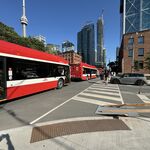Ex-Montreal Girl
Active Member
Where do you get transit score or bike score? I don't see it anywhere.
On walkscore.com, they're below the list of nearby amenities (transit score on the left) and the Google street view (bike on the right.)
Where do you get transit score or bike score? I don't see it anywhere.
On walkscore.com, they're below the list of nearby amenities (transit score on the left) and the Google street view (bike on the right.)
Okay, so I have a transit score of 0.
Still don't see bike score anywhere. Maybe there is not enough info or soemthing.
My address gets "90", a walkers' paradise. Why doesn't my waistline reflect that anymore?
The Street Smart is not very meaningful since it doesn't take into account pedestrian-only routes. Like the sidewalk in front of my house connects directly to Britannia, but my street doesn't connect to Britannia. So my walk score is penalized because they only count the street.
dt_toronto_geek said:My address gets "90", a walkers' paradise. Why doesn't my waistline reflect that anymore?
TOareaFan said:The problem with this system when you get out into the burbs is that it is so dependant on user input.
On Monday (spurred by this thread...so thanks) I went on and logged in and put my postal code. I was a bit surprised by the low transit score so I looked at it and it had me walking .53 km to what it thought was the nearest bus stop. I was able to put in the bus stop that I use on a regular basis. Now when I log in, my transit score is 2 points higher because it is now aware that of the stop that is .37 km from my house. No where, however, does it look at things like frequency of buses at those stops and inter-connectivity with other routes/modes/etc.
The inaccuracy is further shown when I punch in the address that I commute to. Somehow it tells me that I can drive to work in 32 minutes (an impossibility...a good work day it is one hour and 10 minutes...typical is 1 hour and 20 minutes and it can balloon up.......at 6 a.m. on a Sunday it is about 40 minutes)......it also tells me that public transit is 1 hour and 5 minutes...this is actually a pretty good approximation (on days where I leave the car in the garage it has ranged from 55 to 1:20)....but if you looked at those numbers by comparison you would never consider that option!
Walkscores are a good idea...I just think that they are guidelines (nothing more) and their veracity/accuracy lessens the further out from the core of major cities you go.




